| GENE SLOVER'S US NAVY PAGES NAVAL ORDNANCE AND GUNNERY VOLUME 1, NAVAL ORDNANCE CHAPTER 7 TURRET INSTALLATIONS |
| A. Introduction 7A1. General The type of gun emplacement called a turret is, in general, that in which several heavy guns of at least 6-inch caliber are mounted in an armored structure which is revolved on rollers by suitable machinery, the guns being elevated independently of the structure. The Bureau of Ordnance designates ordnance equipment as gun mounts or as gun turrets according to the division of cognizance between that bureau and the Bureau of Ships. In general, if the equipment is massive enough to require assembly of parts on the ship as it is being built, it is called a turret. If the assembly is made in a gun shop and then hoisted aboard as a complete unit, it is called a gun mount. Turret installations on present United States Navy ships are equipped with guns of 6-inch caliber or larger. All turrets have either 2 or 3 guns. They are the primary offensive armament or main battery of cruisers and battleships. 7A2. Turret arrangement Turrets are located fore and aft on the centerline of the ship, so that they are able to fire on either beam. Some turrets are built higher than the adjacent ones, so that they can shoot over them. This arrangement provides the maximum arc of fire, usually about 300 degrees per turret. 7A3. Turret armor All turret structures are protected by armor plate. The gun house is protected by heavy armor plate on the face, sides, roof, and rear. Surrounding the rotating structure below the gun house and extending to the armored decks of the ship, is a fixed cylinder of heavy armor called the barbette. The lower spaces of the turrets are protected by the side armor belt of the ship, and by the armored decks of the ship. All the turret structures, therefore, including the powder stowage magazines, are completely surrounded by heavy armor protection. 7A4. Description of a typical bag-gun turret All turrets equipped with bag guns are essentially similar. The major portion of this chapter is devoted to a detailed description of the 16-inch 50-caliber 3-gun turret as installed on the Iowa class battleships. Other modern major-caliber turrets such as the 16”/45 caliber, 12”/50 caliber, and 8”/55 caliber (Baltimore class) differ from the turret described in many mechanical details, but in general the installations and equipment perform the same basic functions. Therefore, if the operation of one of these assemblies is thoroughly understood it is a relatively simple matter to learn the details of the others from appropriate ordnance publications. The 16-inch 50-caliber turret has its equipment located on six separate levels. These are (1) the gun house, (2) the pan floor, (3) the machinery floor, (4) and (5) the upper and lower projectile flats and (6) the powder-handling room. See figure 7A1. The first (upper) level, or gun house, contains the turret officer’s control booth, the gun compartments, and the right and left sight stations. See figure 7A2. All of these compartments are separated by flametight bulkheads. The after part of the gun house contains the only entrance hatch to the turret from the weather deck. The hatch opens into the turret officer’s booth. Located in the booth are the range-finder, the local control computer, the fire control and communications circuits necessary for turret control, and the power equipment for the rammer mechanisms. The three separate gun compartments, or gun rooms as they are commonly called, have the controls and equipment necessary for servicing the guns. The two sight stations contain duplicate equipment for the operation of the turret optical sights by the pointers, trainers, and sight setters. The second level, counting downward, is called the pan floor. It contains the pockets or open pits into which the breeches of the guns are depressed as the guns are elevated. It also contains operating machinery as shown in figure 7A3. The third level (downward) is the machinery floor on which are located the stations for the three gun layers and the turret trainer. They operate the machinery which moves the guns in elevation and the turret in train in response to fire control orders. This level is a maze of electric-hydraulic machinery necessary for turret operation. See figure 7A4. The next two levels down are the upper and lower projectile stowage and handling rooms, shown in figure 7A5. Here the projectiles are taken from the stowages, loaded into hoists, and lifted up into the gun rooms. The lowest level is the powder-handling room. Surrounding the handling room are the fixed powder stowage magazines. The bags of powder are passed from the magazines through flameproof openings called powder scuttles into the handling room. Here the bags are loaded into elevator-type hoists which deliver them to the gun rooms. |
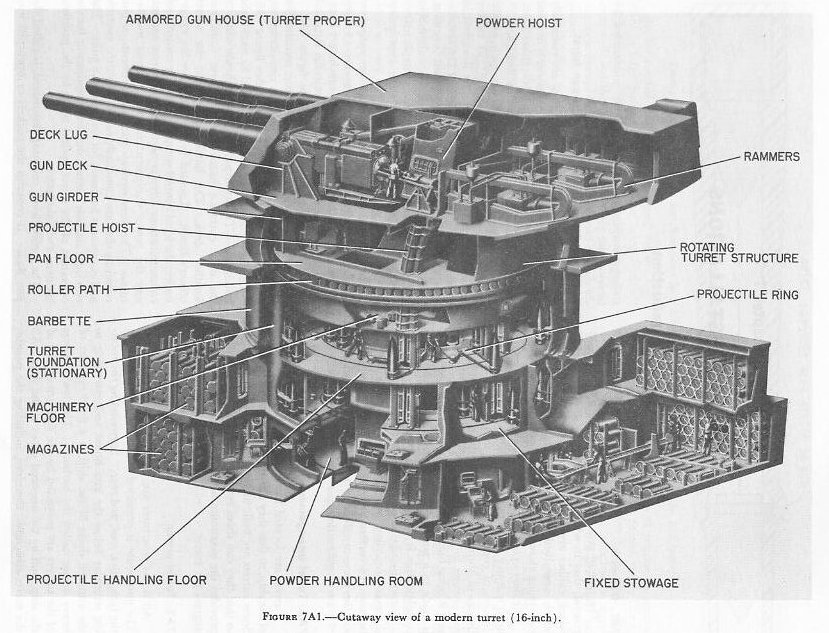 |
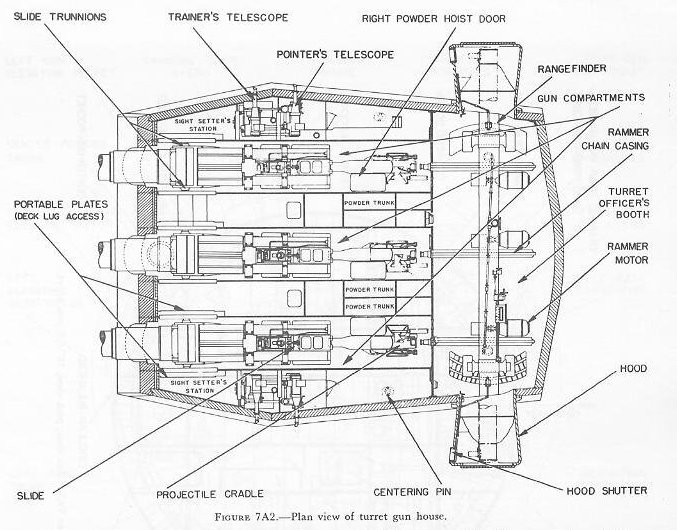 |
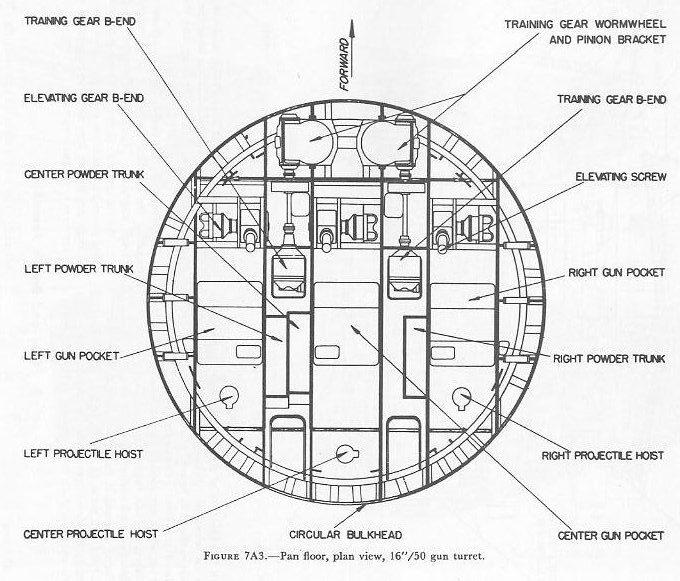 |
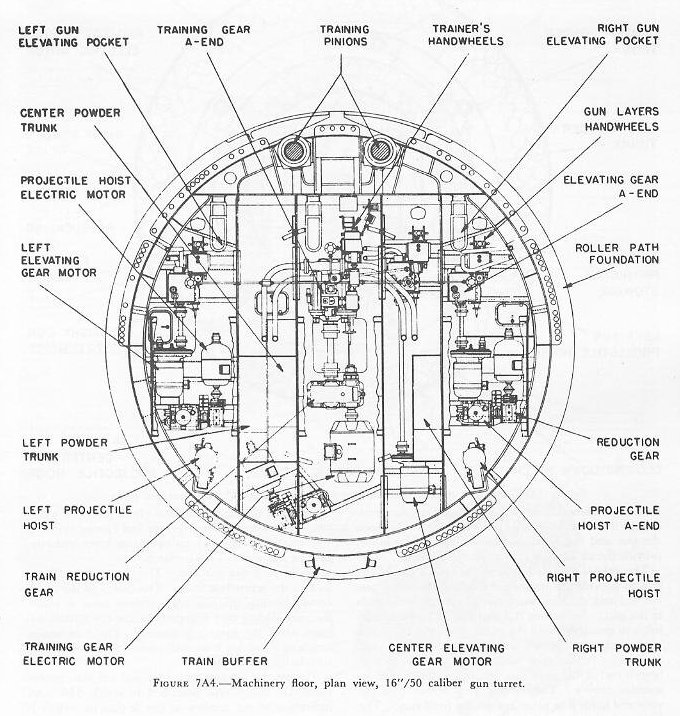 |
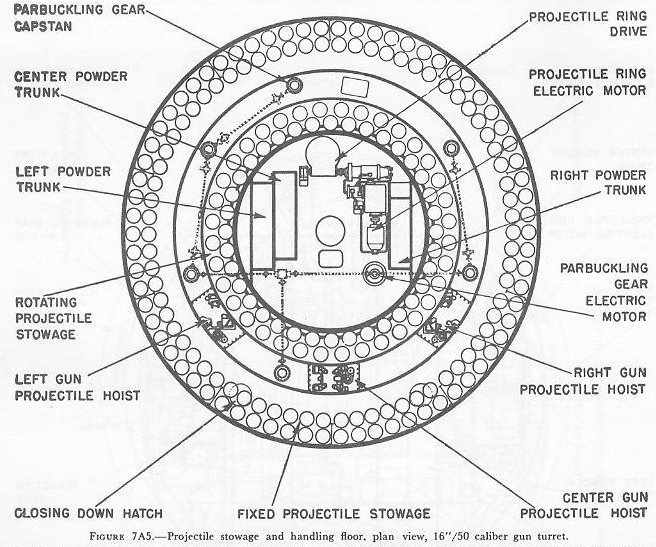 |